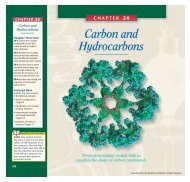You also want an ePaper? Increase the reach of your titles
YUMPU automatically turns print PDFs into web optimized ePapers that Google loves.
SECTION 9-4<br />
Classroom Practice<br />
The following may be used<br />
as teamwork exercises or for<br />
demonstration at the chalkboard<br />
or on an overhead projector.<br />
PROBLEM<br />
The ideal gas law<br />
A sealed tank <strong>with</strong> a volume of<br />
0.10 m 3 contains air at 27°C<br />
under pressure 1.8 × 10 4 Pa. The<br />
valve can <strong>with</strong>stand pressures up<br />
to 5.0 × 10 4 Pa. Will the valve<br />
hold if the air inside the tank is<br />
heated to 227°C?<br />
Answer<br />
Yes, the pressure will go up<br />
only to 3.0 × 10 4 Pa.<br />
The volume of a weather balloon<br />
is 8.0 m 3 at 3.0 × 10 2 K under<br />
atmospheric pressure. The balloon<br />
rises to an altitude where<br />
the temperature is 2.0 × 10 2 K<br />
and the pressure is ⎯ 1<br />
2 ⎯ of atmospheric<br />
pressure. What is its new<br />
volume?<br />
Answer<br />
11 m 3<br />
340<br />
340<br />
SAMPLE PROBLEM 9E<br />
PROBLEM<br />
SOLUTION<br />
1. DEFINE<br />
2. PLAN<br />
3. CALCULATE<br />
4. EVALUATE<br />
Chapter 9<br />
The ideal gas law<br />
Given: V 1 = 15 L P 1 = 2.0 atm T 1 = 310 K<br />
V 2 = 12 L P 2 = 3.5 atm<br />
Unknown: T 2 = ?<br />
This section, however, considers confined gases whose pressure, volume,<br />
and temperature may change. For example, when a force is applied to a piston,<br />
the gas inside the cylinder below the piston is compressed. Even though an<br />
ideal gas behaves like an ideal fluid in many situations, it cannot be treated as<br />
incompressible when confined to a container.<br />
Pure helium gas is contained in a leakproof cylinder containing a movable<br />
piston, as shown in Figure 9-17. The initial volume, pressure, and<br />
temperature of the gas are 15 L, 2.0 atm, and 310 K, respectively. If the gas<br />
is rapidly compressed to 12 L and the pressure increases to 3.5 atm, find<br />
the final temperature of the gas.<br />
Choose an equation(s) or situation: Because the gas undergoes a change and<br />
no gas particles are lost, the form of the ideal gas law relating the initial and<br />
final states should be used.<br />
P<br />
⎯<br />
1V1<br />
⎯ = ⎯<br />
T1<br />
P2V2<br />
⎯<br />
T2<br />
Rearrange the equation(s) to isolate the unknown(s):<br />
T2P1V1 = T1P2V2 T2 = T1⎯P 2V2<br />
⎯ P1V1<br />
Substitute the values into the equation(s) and solve:<br />
⎯<br />
T2 = (310 K)⎯( 3.<br />
5 atm)<br />
( 12<br />
L)<br />
( 2.<br />
0 atm)<br />
( 15<br />
L)<br />
T 2 = 4.3 × 10 2 K<br />
Because the gas was compressed and the pressure increased, the gas temperature<br />
should have increased.<br />
430 K > 310 K<br />
Gas<br />
Figure 9-17<br />
CALCULATOR SOLUTION<br />
Your calculator should give the<br />
answer as 434. However, because<br />
the values in the problem are known<br />
to only two significant figures, the<br />
answer should be rounded to 430<br />
and expressed in scientific notation.<br />
Copyright © by Holt, Rinehart and Winston. All rights reserved.
















